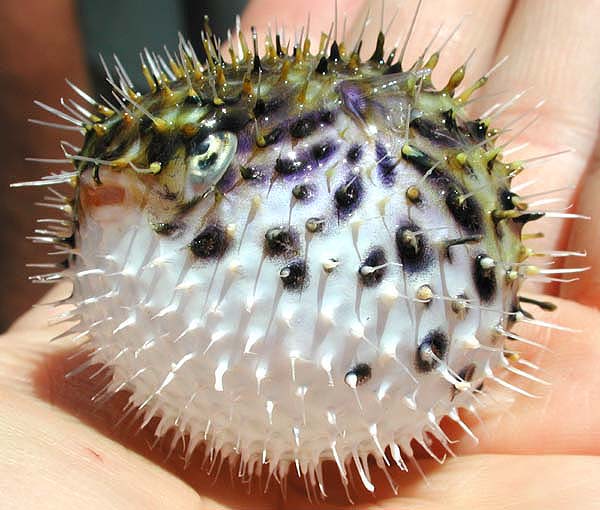THE PUFFERFISH
by Oonagh McDowell
Description
The pufferfish belongs to a family called tetraodontida. This category also includes balloonfish, blowfish, bubblefish, globefish, swellfish, toadfish, honey toads, toadies and sea squab.


The puffer fish looks like a normal little fish at first sight, but when it feels threatened or scared it will puff up like a balloon and the little spikes that are barely visible when it is at its normal stage, stick out. The puffer fish is normally white on its stomach with different shades of brown on top. the average size of a pufferfish is around the size of a normal tea cup, but the they can get up to 3 feet big when they puff. Like the Stingray, the pufferfish is and looks absolutely harmless until it feels threatened. in that case, it can kill a human with the poison in its spikes.


Habitat

The light yellow represents the area of the world that is inhabited by pufferfish.
Most puffer fish live in tropical or sub-tropical waters, which includes the Indian, Pacific and Atlantic Oceans. Puffer fish are rarely found in deep oceans and seas, they are mostly found in coastal reefs, although you can find some in deep sea. About 39 species of pufferfish swim into fresh water to breed and to feed.
Predator Adaptations
Puffer fish are carnivores, they feed off of little animals like mollusks and crustaceans. The reason that they are able to crush the shells of their prey, is because they have four large teeth that are stuck together forming a plate. Puffer fish have this plate on both the upper and lower jaw which makes a fairly strong jaw for a fish of that size. 
Pictures of different types of molluscs. (Blue-ringed Octopus' are a type of mollusk, but pufferfish dont eat them)

Picture of a crustacean
The reason that pufferfish eat little animals like these, is because, although they live in the ocean, they are not very good swimmers. Instead of killing their prey with their mouth, they kill the prey with their poisonous spikes and then they eat it. They are able to crunch the shells of their prey with their strong jaw/plate. This technique is very much like the Sea Anemone which paralyses its prey and then eats it.
Prey Adaptations
.The pufferfish is eaten by animals that have a strong enough metabilism to digest spikes. Some examples of these are, the Tiger shark, the sea anemone and humans. humans usually dont eat pufferfish for fear of being poisoned. but in japan, pufferfish is a considered a great delicacy called fugu.
 (fugu, Japanese delicacy)
(fugu, Japanese delicacy)
The pufferfish can protect itself from prey by puffing itself up like a balloon. Most predators will be afraid to even try it, because it is big, round, pointy and colorful but the braver, bigger predators will try it and either be poisoned and die or just get a mouth full of spikes. That is why only the tiger shark, the sea anemone, humans and a few other animals can eat them. If a sea animal does get poisoned and die from the pufferfish, than animals that normally wouldn't eat the dead animal, will eat it because it is easy prey.
Symbiotic Interactions
The pufferfish fits into the category of Mutualism. The species that the pufferfish has a mutualistic relationship with is coral. The reason that coral has a mutualistic relationship with the pufferfish, is because a coral reef holds little clams and sea snails that the pufferfish eats, so therefore, the coral reef helps the pufferfish. The pufferfish helps the coral reef by eating the small little fish that live in it, because if the pufferfish didn't eat any of the coral reef fish, then the coral reef would overflow with fish. If the reef overflowed with fish then that would ruin the food chain of the reef, for example, there would be too many species of one animal and they would over breed, therefore, animals like the Sea Turtle or the Bottlenose Dolphin will eat overeat, then they will overbreed. If animals that overpopulate part of the ocean then they would eat all the small animals that do not have as big of a population and those animals will go extinct. Thats why the pufferfish has a mutualistic relationship with the the coral reef

Species comparison with the stingray
Similarities:
- They are both friendly and gentle when they do not feel threatened
- They are both carnivores
- they both live in the great barrier reef
- they are both vertebrate
- both live in warm sub-tropical areas
- they both eat clams, mollusks, oysters, small fifh, crustaceans, snails, crabs, worms and other invertebrates
- they both have poisonous spikes that can kill a human
- They both use coral reef as their hunting grounds
- they are both eaten by tiger sharks
- they are both mutualistic
Differences:
- The are completely different sizes
- The stingray lives around 15 years and the pufferfish only lives for 5 years at the most.
- pufferfish has many spikes and the stingray only has 1
- the stingray is flat and the pufferfish is round
- The puffer fish comes in different shades of brown, yellow and pink and the pufferfish comes in shades of grey, black, white and sand colored.
- the pufferfish has little fins that are a whole separate part if its body and the stingray has fins that look as if they are all one body part.
resource's:
Comments (2)
Emily J said
at 8:20 pm on Feb 16, 2010
I made a link to yours!!!! haha I can't believe I knew how!!!
Your page is really good!!
Hugh H said
at 6:47 pm on Feb 22, 2010
Hi Oonagh! nice pics!!
You don't have permission to comment on this page.